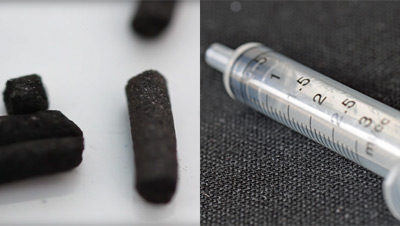As if our hobby weren’t perplexing enough to the average beginner given all the oddball jargon we toss around, things can get doubly befuddling for novices when they come across two or more similar-sounding terms that actually apply to very different concepts.
Such confusion could easily arise, for example, when newcomers are first confronted with the concepts of carbon use for chemical filtration and carbon dosing for nitrate/phosphate reduction. So, to help clarify these sound-alike terms, let’s define what they are and how each is used to maximize water quality in a marine aquarium:
Chemical filtration with activated carbon
Likely, activated carbon is what comes to mind for many new hobbyists when they first hear or read about carbon use in marine aquaria, especially if they have a background in freshwater fishkeeping where activated carbon use is a long-established practice.
Activated carbon (aka activated charcoal) is a highly porous medium, typically sold in granular or pelletized form, that is used to remove dissolved organic compounds (DOCs) from aquarium water. It’s considered a chemical filtration medium because the DOC molecules it removes actually form a bond with the surface of the carbon—a process known as adsorption.
DOCs are what cause the yellowing of aquarium water, so their removal with activated carbon helps keep the water crystal clear. Activated carbon can also be used to eliminate various toxins and contaminants from the water, for example the noxious chemicals many corals and other sessile organisms release to prevent neighbors from encroaching on their real estate, medications used to treat fish, residual ozone exiting an ozone reactor, etc.
There are various ways to place the carbon granules or pellets in a system. To list a few possibilities, they can be enclosed in some sort of flow-through pouch and situated in a high-flow area of the tank, sequestered in a mechanical filter compartment, or placed in a dedicated carbon reactor.
Carbon dosing for nitrate/phosphate reduction
As the name suggests, carbon dosing involves the introduction of an organic carbon source to the water, commonly in the form of vodka, sugar, vinegar, or so-called biopellets or similar media. Another source of confusion in all this is the fact that biopellets are used in a dedicated reactor, just as activated carbon can be. However, they—and all these other sources—do a very different job from that described above for activated carbon.
Carbon dosing is all about harnessing the power of bacteria (and you thought bacteria were only good for cycling!). The carbon serves as a food source for heterotrophic bacteria that also take up nitrate and phosphate.
But the process doesn’t stop there. Carbon dosing needs to be performed in conjunction with vigorous protein skimming, which exports the bacteria, along with any nitrate/phosphate they’ve taken up, from the aquarium system. Skimming is also necessary to help prevent oxygen depletion as a result of the bacterial blooms this methodology promotes.
For hobby newcomers reading this, I should emphasize that carbon dosing is by no means a necessary element of marine aquarium husbandry. In fact, administered incorrectly or haphazardly, carbon dosing can do far more harm than good. If you wish to experiment with this technique, proceed with caution and only after doing as much research as possible on the topic.



